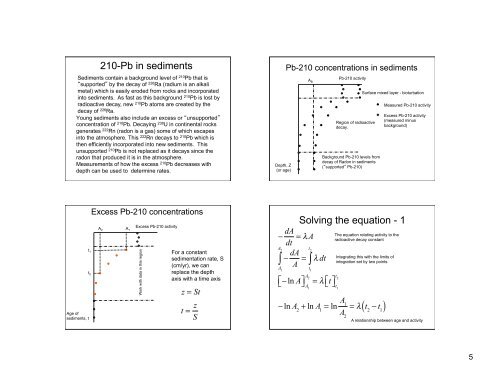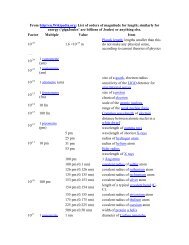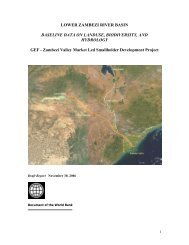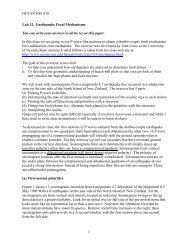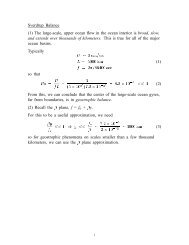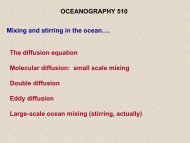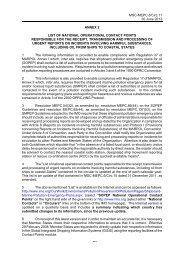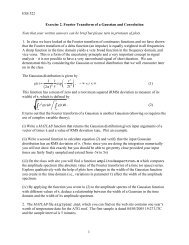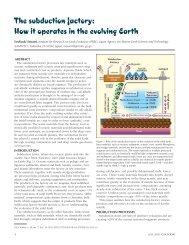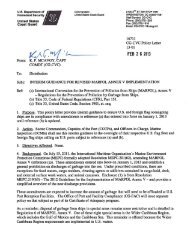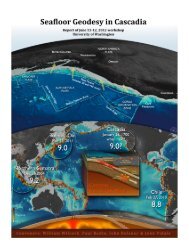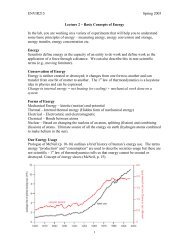16. Sediment Transport Across the Continental Shelf and Lead-210 ...
16. Sediment Transport Across the Continental Shelf and Lead-210 ...
16. Sediment Transport Across the Continental Shelf and Lead-210 ...
You also want an ePaper? Increase the reach of your titles
YUMPU automatically turns print PDFs into web optimized ePapers that Google loves.
<strong>210</strong>-Pb in sediments<br />
<strong>Sediment</strong>s contain a background level of <strong>210</strong> Pb that is<br />
supported by <strong>the</strong> decay of 226 Ra (radium is an alkali<br />
metal) which is easily eroded from rocks <strong>and</strong> incorporated<br />
into sediments. As fast as this background <strong>210</strong> Pb is lost by<br />
radioactive decay, new <strong>210</strong> Pb atoms are created by <strong>the</strong><br />
decay of 226 Ra.<br />
Young sediments also include an excess or unsupported<br />
concentration of <strong>210</strong> Pb. Decaying 238 U in continental rocks<br />
generates 222 Rn (radon is a gas) some of which escapes<br />
into <strong>the</strong> atmosphere. This 222 Rn decays to <strong>210</strong> Pb which is<br />
<strong>the</strong>n efficiently incorporated into new sediments. This<br />
unsupported <strong>210</strong> Pb is not replaced as it decays since <strong>the</strong><br />
radon that produced it is in <strong>the</strong> atmosphere.<br />
Measurements of how <strong>the</strong> excess <strong>210</strong> Pb decreases with<br />
depth can be used to determine rates.<br />
Depth, Z<br />
(or age)<br />
Pb-<strong>210</strong> concentrations in sediments<br />
A B<br />
Pb-<strong>210</strong> activity<br />
Region of radioactive<br />
decay.<br />
Background Pb-<strong>210</strong> levels from<br />
decay of Radon in sediments<br />
(supported Pb-<strong>210</strong>)<br />
Surface mixed layer - bioturbation<br />
Measured Pb-<strong>210</strong> activity<br />
Excess Pb-<strong>210</strong> activity<br />
(measured minus<br />
background)<br />
t 1<br />
t 2<br />
Age of<br />
sediments, t<br />
Excess Pb-<strong>210</strong> concentrations<br />
A 2 A 1<br />
Excess Pb-<strong>210</strong> activity<br />
Work with data in this region<br />
For a constant<br />
sedimentation rate, S<br />
(cm/yr), we can<br />
replace <strong>the</strong> depth<br />
axis with a time axis<br />
z = St<br />
t = z S<br />
! dA<br />
dt = " A<br />
A 2<br />
Solving <strong>the</strong> equation - 1<br />
" ! dA = # dt<br />
A<br />
A 1<br />
t 2<br />
"<br />
t 1<br />
A<br />
"# ! ln A$ 2<br />
% A1<br />
= & " # t $ t 2<br />
% t1<br />
The equation relating activity to <strong>the</strong><br />
radioactive decay constant<br />
Integrating this with <strong>the</strong> limits of<br />
integration set by two points<br />
! ln A 2<br />
+ ln A 1<br />
= ln A 1<br />
= "( t<br />
A 2<br />
! t 1 )<br />
2<br />
A relationship between age <strong>and</strong> activity<br />
5


